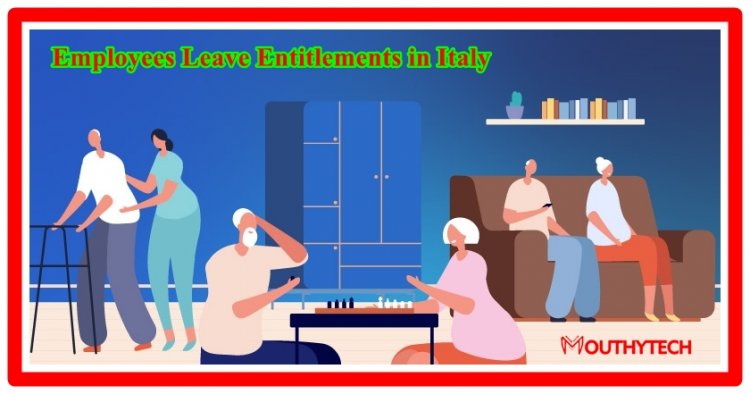Employees Leave Entitlements in Italy
All employees are entitled to annual paid leave in the country of Italy. The Italy Civil Code provides for a statutory minimum leave of eight days, for domestic employees only. The minimum leave of all other employees is determined by collective agreements, which generally provide for paid annual leave of not less than four weeks per year.

Some agreements foresee additional vacation on the ground of seniority. During their vacation, employees receive regular pay, excluding only indemnities connected to the actual work.
However, apart from annual leave, the employees still have some leave entitlements base on the condition of the work environment, the employee's health, etc. Below are some leave entitlements for Italian employees.
Italy, a European nation with a long coastline along the Atlantic, has had a profound impact on Western cuisine and culture. Rome, the nation's capital, is home to the Vatican and notable works of art and ancient ruins. Other important cities include Florence, home to Michelangelo's "David" and Brunelleschi's Duomo; Venice, the city of canals; and Milan, the fashion capital of Italy.
Annual leave in Italy:
Employees are entitled to a minimum of four weeks of paid vacation a year and 12 paid public holidays. Collective bargaining agreements and individual contracts can provide a more extended period of paid holiday entitlement. Minimum paid annual leave in Italy cannot be replaced by a payment, except where the employment contract is terminated. There is no statutory unpaid holiday entitlement. However, a collective bargaining agreement can provide for unpaid leaves of absence.
What is Annual Leave?
Annual leave is a period of paid time off work granted by employers to employees to be used for whatever the employee wishes. Depending on the employer's policies, differing numbers of days may be offered, and the employee may be required to give a certain amount of advance notice, may have to coordinate with the employer to be sure that staffing is the employee's absence, and other requirements may have to be met. The vast majority of countries today mandate a minimum amount of paid annual leave by law.
Among the larger countries, China requires at least five days' paid annual leave and India requires two days of paid leave for every month worked. Italy mandates no minimum paid leave, treating it as a perk rather than a right.
Who’s Entitled to Annual Leave in Italy?
Annual leave entitlement is different in every country. It may also vary from employer to employer. Full-time and part-time employees are generally entitled to paid time off, while independent contractors are not.
However, there may be specific criteria an employee must meet to be eligible for annual leave, such as a minimum length of time at the company or a minimum number of hours worked per week, month, or year.
How Annual Leave Works in Italy:
When an employee wants to take annual leave, they should make an annual leave request to their manager, who’s in charge of approving it. An annual leave application is usually made through an HRIS system, which provides a streamlined process through automation. Once approved, the employee takes the scheduled time off work and, in most cases, receives pay as usual.
While on annual leave, employees typically don’t need to perform any of their usual duties or respond to work emails. One of the primary purposes of annual leave is to give employees sufficient opportunities to rest and recharge.
Maternity leave in Italy:
What is Maternity Leave?
Maternity leave refers to the period that a new mother takes off from work following the birth of her baby. Many companies have similar policies for fathers, which allow for paternity leave. Maternity leave is usually created from various benefits that include sick leave, vacation, holiday time, personal days, short-term disability and unpaid family leave time.
It is essential to plan your maternity leave so that you and your family do not experience any unexpected financial challenges and you can make the most of your time with your baby.
All pregnant employees, regardless of the length of service, are entitled to maternity leave. Even when applying for a job, a woman is not under a duty to tell a prospective employer that she is pregnant. Pregnant workers must take five months’ maternity leave (compulsory rest period) which can be taken from two months before childbirth to three months after.
During the compulsory rest period, the mother is entitled to 80% of her regular pay from the social security authority and the period is counted as actual work time. In addition to the pay received by the social security authority, CCNLs usually require the employer to make up the difference in remuneration so that the worker receives their normal earnings.
When coming back to work at the end of maternity leave, the employer must give the employee the same position, task, and duties that were carried out before.
A woman cannot be dismissed from the beginning of pregnancy until one year after the child’s birth (the protected period). Maternity leave can be converted into paternity leave (regardless of whether the mother is an employee or freelancer) in three circumstances:
When to take my maternity leave in Italy:
Some women begin taking their leave a week to a month before the expected birth because of discomfort or the desire for time to prepare. Others wait until the last moment so they can maximize their time with the baby once it arrives.
The FMLA requires that you provide your employer with at least a 30-day notice of your intentions to take unpaid family time. Your boss will appreciate any additional advance notice to plan for when you are absent.
Recommendations for Maternity Leave in Italy:
There are several things you can do to make your maternity leave the best possible for both you and your employer:
- Check in with your human resources department to find out the details about your maternity leave options. This will help you plan for your best maternity leave options.
- Sit down with your partner and evaluate what time you can afford to take. You and your employer should know the plan ahead of schedule.
- After completing your first trimester, start the communication with human resources and those affected by your leave to help all parties prepare. Some employers are less friendly to pregnancy than others. You may need to evaluate the best time to share the news based on previous experiences you have witnessed in the office.
Provide your boss with suggestions and strategies to address your duties while you are gone, insights on what projects you are working on, and suggested co-workers to meet your responsibilities while on leave. This can help overcome the potential concerns noted above.
Sick leave in Italy:
What is Sick Leave?
Sick leave is paid time off from work that workers can use to stay home to address their health needs without losing pay. It differs from paid vacation time or time off work to deal with personal matters because sick leave is intended for health-related purposes. Sick leave can include a mental health day and taking time away from work to go to a scheduled doctor's appointment. Some policies also allow paid sick time to be used to care for sick family members or to address health and safety needs related to domestic violence or sexual assault. Menstrual leave is another type of time off work for a health-related reason, but it is not always paid.
Collective bargaining agreements and individual contracts usually provide for paid time off for illness and injury. The employee is entitled to keep their job and receive their salary in proportion to the period set out in the collective bargaining agreement or individual employment contract. If no agreement exists, statutory sick pay is a benefit that replaces pay, starting from the fourth day of absence from work. The first three days are “waiting days,” unless the illness is relapse. If stated in the employment contract, the “waiting days” are paid in full by the employer. Entitlement to the benefit ends at the end of illness. Statutory sick pay is paid for a maximum of 180 days per calendar year.
In most parts of the world, annual leave is treated separately from sick leave and personal leave. While annual leave can be used for any reason, sick leave is specifically intended for health-related purposes. Personal leave can be another name for sick leave but may also incorporate things like family emergencies.
Like annual leave, the amount of paid sick days or personal days an employee is entitled to depends on local laws or individual employment contracts.
However, in Italy, employers generally don’t distinguish between paid annual and sick leave. This is because there’s no federal obligation to provide either. Instead, employers often offer “paid time off” or “personal time off” (PTO) as an employee benefit. PTO typically combines vacation days, sick days, and personal days into one yearly allowance.
The Eligible for Sick Leave in Italy:
Eligibility criteria for sick leave and sick pay differ across the world. Some countries have more requirements than others, but typically they cover factors like employee type (e.g., office worker vs. manual worker), job tenure, contributions to social security, length of sickness, and reason for sick leave.
In some jurisdictions, there’s a waiting period for sick pay, which means employees aren’t eligible to receive payments until they’ve been off work for a certain number of days. For example, France has a waiting period of three days, so employees are only entitled to pay if they remain off work for four days or more.
The major Reasons for Sick Leave in the country of Italy:
The permitted reasons for taking sick leave depend on local regulations and employer policies. As a general rule, if employees cannot do their work as usual due to ill health, they can take sick leave.
Sick leave reasons may include:
- Contagious illness
- Physical injury or illness
- Mental health-related illness (including “stress leave”)
- Medical appointments
- Hospitalization
In some cases, employees may take sick leave to care for an unwell family member, but often this is classified as emergency leave, special leave, or compassionate leave instead.
Sabbatical leave:
Simply put, sabbatical leaves are “a break from work” where employees can pursue their interests or take time off for physical and mental health reasons. Unlike other leaves, sabbaticals are long leave periods, from six months to a year. Sabbaticals are commonly taken by employees at educational institutions where professors may want to take a break from their teaching role to research their projects.
Companies whose employees have served them for more than 3 years often give these employees a sabbatical leave to reward them for their loyalty and hard work.
Religious holidays:
Christmas, Eid, Easter, Holi, Yom Kippur— your employee is sure to place importance on religious holidays that they celebrate and would want the day off to spend time with their family and observe the festival. You must accommodate these holidays they have by providing them with the option to take leave on the day of the festival.
Take note of every religious holiday from resources online and ask employees to send a message to you every year, listing the religious holidays that they want time off for.
Compensatory leave:
Employees who have clocked in more hours than they were required to can be eligible for compensatory days off. Ensure that any employee who has put more time in or come to work on days they were off (like Saturday) is given a compensatory day off or “comp off”.
Compensatory time-off must be automatically recorded within your backend and employees must be informed that they have an extra day of leave for the time they put in.
Casual leave:
Casual leave is taken by an employee for travel, vacation, rest, and family events. Such leaves allow the employee to take time off for any life events like traveling to another country or weddings they have to attend. Giving employees paid casual leave will allow them to prioritize their private life when required, making them feel appreciated in the company.
In most companies, employees can take a maximum of 8 to 15 days of casual leave in a year.
Paternity leave:
Paternity leave is granted to new fathers— husbands or partners of a pregnant woman, surrogate parent, or someone who adopted a child— to take care of their newborns without worry.
Unlike maternity leaves, new fathers usually get 2 weeks of leave to take care of their child post-delivery. Some countries mandate 1 to 2 weeks of paternity leave for new fathers.
Companies rarely provide paternity leave for the birth of their child since such leaves are not mandatory by law. However, HRs must recognize the stresses of adjusting to the newborn and taking care of the child in their first few days.
Public holiday in Italy:
Public holidays are days that are given as leave by the government of Italy. Such holidays must be observed by every institution— schools, banks, government offices, and even private companies. Public holidays include Independence Day, Memorial Day, Labor Day, bank holidays, and any nationally-recognized day like the death of a prominent leader of the country.
Include these leaves within your leave policy by looking into the holidays that your government has mandated for your country.
Bottom Line:
"Employees Leave Entitlements in Italy" is an article that brings out the off days of workers in Italy.
The article further explains the meaning of leaves, the meaning of maternity leave, the meaning of annual leave, the eligibility for annual leave, how annual leave works, sick leave, the eligibility for sick leave, the primary reason for sick leave, the sabbatical leave, Religious holidays leave, compensation leave, casual leave, paternity leave, and public holiday leave.
What's Your Reaction?




















